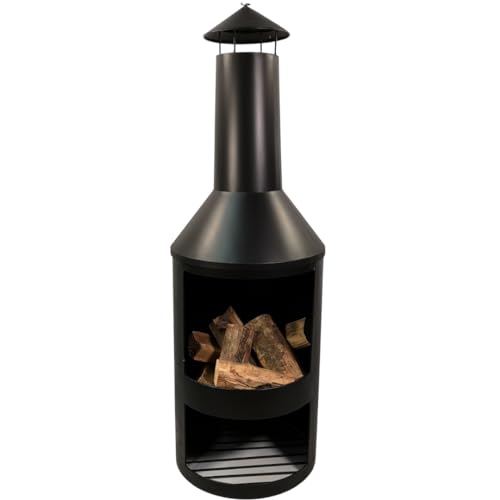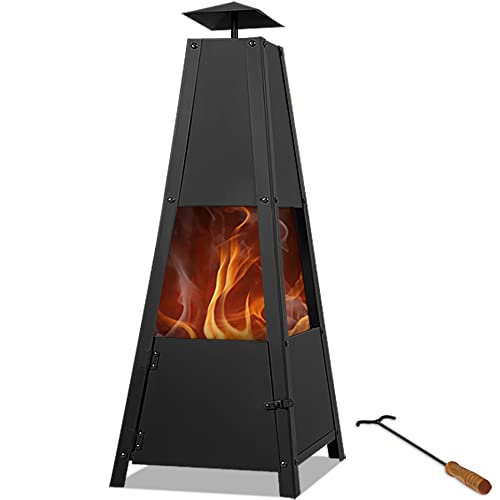Nine Things That Your Parent Taught You About Mexican Chimineas
페이지 정보

본문
 Chimineas - An Authentic Mexican Fire Pit
Chimineas - An Authentic Mexican Fire PitThe first time they were used was as a bread oven, chimineas reflect Mexico's rich heritage of culture. The simple design, blending practicality and aesthetic simplicity is timeless.
Chimineas of clay can be fired in kilns, which remove organic matter from the clay and seals the pores to prevent cracking. They are made to be outdoors all year long, but must be protected from prolonged exposure to the elements.
Origins
Imagine a warm evening in the summer, with family and friends enjoying delicious food outdoors with a warm Mexican or clay chiminea. It's a picture an ode to the Mexican roots of this type of outdoor firepit.
These traditional terracotta stoves were made to be both radiant heaters and ovens. They were used to help tribesmen endure the cold desert nights in their homeland. Their distinctive design was derived from their utilitarian characteristics that emphasized practicality and the importance of living in a communal setting.
In the beginning, these stoves were made from natural terracotta clay that was dried in kilns and then wood-fired. Chimineas made of clay are more rustic and do not have a glazed surface to protect them. modern chiminea manufacturers produce chimineas using metals like brass, cast iron, and aluminum. These materials provide enhanced durability and weather resistance and address one of the major weaknesses of the clay design.
The distinctive design of the chiminea was inspired by the idea of a potbellied base that rises into an extended chimney. This design is a great way to contain fire while also directing smoke upwards, which minimizes the possibility of air inhalation and enhances heat retention.
Chimineas were a popular method of lighting, heating and cooking. Today, we can appreciate them for their beauty and the warm comfort they offer on chilly autumn evenings and even in the chilly winter sun.
Gardeco offers a variety of styles that will suit your garden. We have a variety of sizes, ranging from small to extra-large. We also carry clay chimineas which have been decorated with either engraving or a moulded design.
Our range of terracotta Chimineas and Mexican chimineas is handmade by artisans from the heart of Mexico. The manufacturing process can cause minor variations in the shape and colour. If your Chiminea (https://www.Metooo.Io) starts to fade, you can always repaint it using an emulsion water-based paint. Before using your new chiminea, it is crucial to follow all instructions and tips for care provided by the manufacturer.
Design
Chimineas are not just useful, but they also provide an authentic and rustic feel to the space. They are available in a variety of styles and materials and can be combined with any furniture for your patio. They can be a focal point or blend in seamlessly with the landscape.
The clay chimenea was designed to be practical as well as for cultural reasons. The tall chiminea chimney-like neck directed smoke away from users, and its rounded body radiates warmth. It was also used to socialize and tell stories, which played a significant role in Mexican and Central American cultures.
Traditionally, chimineas were handcrafted by local artisans from wet clay that was taken directly from the ground. The raw material was formed into its final form before being kiln dried. The process of creating a clay chimenea was extremely labor-intensive, especially for huge ones. The chiminea's bowl and neck are made by smoothing together long snakes of clay rolled. The clay's rim was often decorated with carvings and patterns.
Modern chimineas are generally constructed from metals like cast-iron or aluminum. The introduction of chimineas made from metal was an important evolutionary step because they are able to stand up to extreme temperatures and humidity without cracking. This change allowed chimineas to be used in a broad range of climates.
Metal chimineas are the most common however there are certain companies that make clay and terracotta chimineas. The advantages of using metal chimineas include its capability to withstand higher temperatures as well as the fact that it is able to be cleaned more easily. Metal chimineas are more popular than clay chimineas since they can endure higher temperatures and be cleaned easier.
No matter what type of chiminea that you select, it's essential that you place it in the right spot. It should be placed in a level space and away from any fire-prone objects like grass, trees, or other buildings. The chiminea should be placed on a concrete patio, brick patio or stone terrace and not on a wood deck. It's also recommended to place 50mm of sand or Gardeco lava stones beneath the chiminea to shield it from direct heat and keep the hot part of the fire from the clay.
Materials
Traditional clay and terracotta chimineas which are still manufactured by small companies today, are fired to temperatures up to 1000c. After they have cooled and dried, the chimineas can be assembled. Some are glazed while others remain unglazed. Chimineas can give a Mexican feeling in a garden.
Chimineas can be painted by hand in a variety of colours and patterns to match different styles. The paint finish will fade due to time and heat of the fire so it is recommended to paint again using a water-based emulsion.
Originally designed to provide cooking and heating facilities for Mexicans living in towns, chimineas over the years have evolved into a cultural symbol, adapting their function to satisfy a variety of requirements. In addition to serving as bread ovens for the indigenous people of Mexico, these distinctive structures also played a vital role in repelling insects and in promoting social gatherings.
The unique design of a chiminea having a wide base and a narrow chimney spout, allows the most air to be drawn in from the bottom of the structure, reducing smoke inhalation. It also helps to retain the heat inside the chiminea, making it ideal to cook over.
Chimineas are found in a variety of materials including cast iron, terracotta clay and even aluminum. Terracotta Chimineas are the most common choice, offering the traditional Mexican style. They are prone cracking when under pressure and should be placed on flat surfaces that are fire-safe. Cast iron and aluminum chimineas aren't as susceptible to cracking and damage, but they are elegant and sturdy.
To ensure that the chiminea lasts as long as possible, it should always be kept in a well-ventilated space and protected from wind and rain. It should be placed away from walls and structures that could catch fire, and also any eaves and patio roofs that may be damaged by a sudden change in temperature once the chiminea has been extinguished. In order to prevent the chiminea from smoking excessively, it is advised to keep the leaves away and only seasoned, kiln dried logs are burned. Regular cleaning with a wire brush is also crucial, as it helps prevent build up of deposits that are liable to burn and blacken. Chimineas can be protected from wind, which will reduce the amount of smoke it releases.
Maintenance
Proper maintenance is crucial to the longevity of any fire equipment. This will help extend its lifespan and also ensure that it functions safely. Chimineas are relatively fragile and should always be kept outside in an area that is well taken care of. While a chiminea made from clay may appear to be sturdy enough, it is still susceptible to cracks and breaking from a variety of sources. This is why it's essential to check your chiminea frequently for signs of wear and tear, and to follow the manufacturer's guidelines on how often it should be fired.
To keep your Mexican chimney looking beautiful it is essential to clean it thoroughly with mild detergent. This will eliminate any dirt or grime that could cause discoloration or rust. A wire brush is used to remove dust and rust particles. it is recommended you use gloves and goggles for safety purposes. After scrubbing, rinse the chiminea and allow it to dry completely. This will stop any moisture from causing corrosion and it can greatly extend the lifespan of your chiminea.
Once your chiminea has been cleaned and dried, it should be lightly sanded using fine grit the sandpaper. This will smooth the surface and eliminate any rough spots which could be caught on the embers as you build an fire. The sanding can also help to make the surface more uniform and attractive. The sanding process can be followed by a series of coats of stove or grill paint, which will improve the appearance of your chiminea barbecue as well as keep it from rust.
Keep your chiminea out of direct sunlight and wind as it can cause the paint to peel off and fade. If this occurs it is possible to touch up the affected areas with water-based emulsion paints or masonry sprays and it's usually easy to do. It is also important to only use small fires and to add small amounts of wood at a time to your chiminea in order to make sure it is "broken in" and to prevent overheating.

- 이전글What's The Job Market For Volvo Car Key Replacement Professionals Like? 24.11.08
- 다음글야코 주소 ※링크나라※ 세상모든링크 성인 밤토끼 24.11.08
